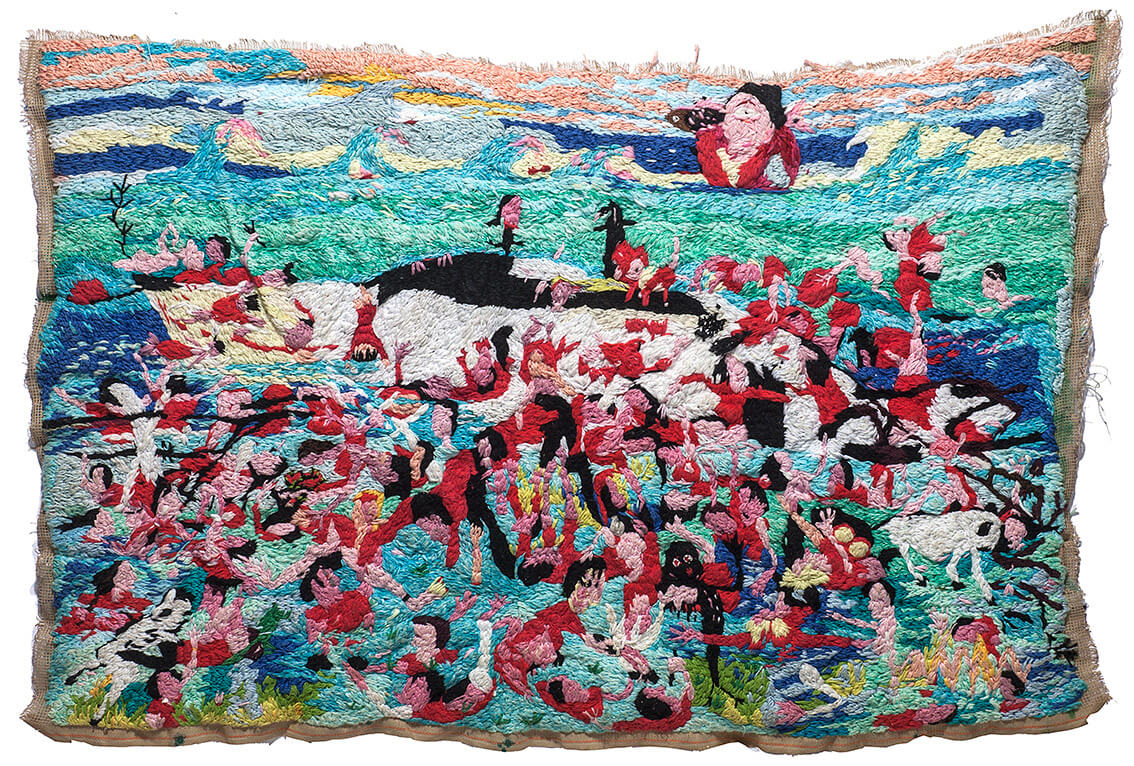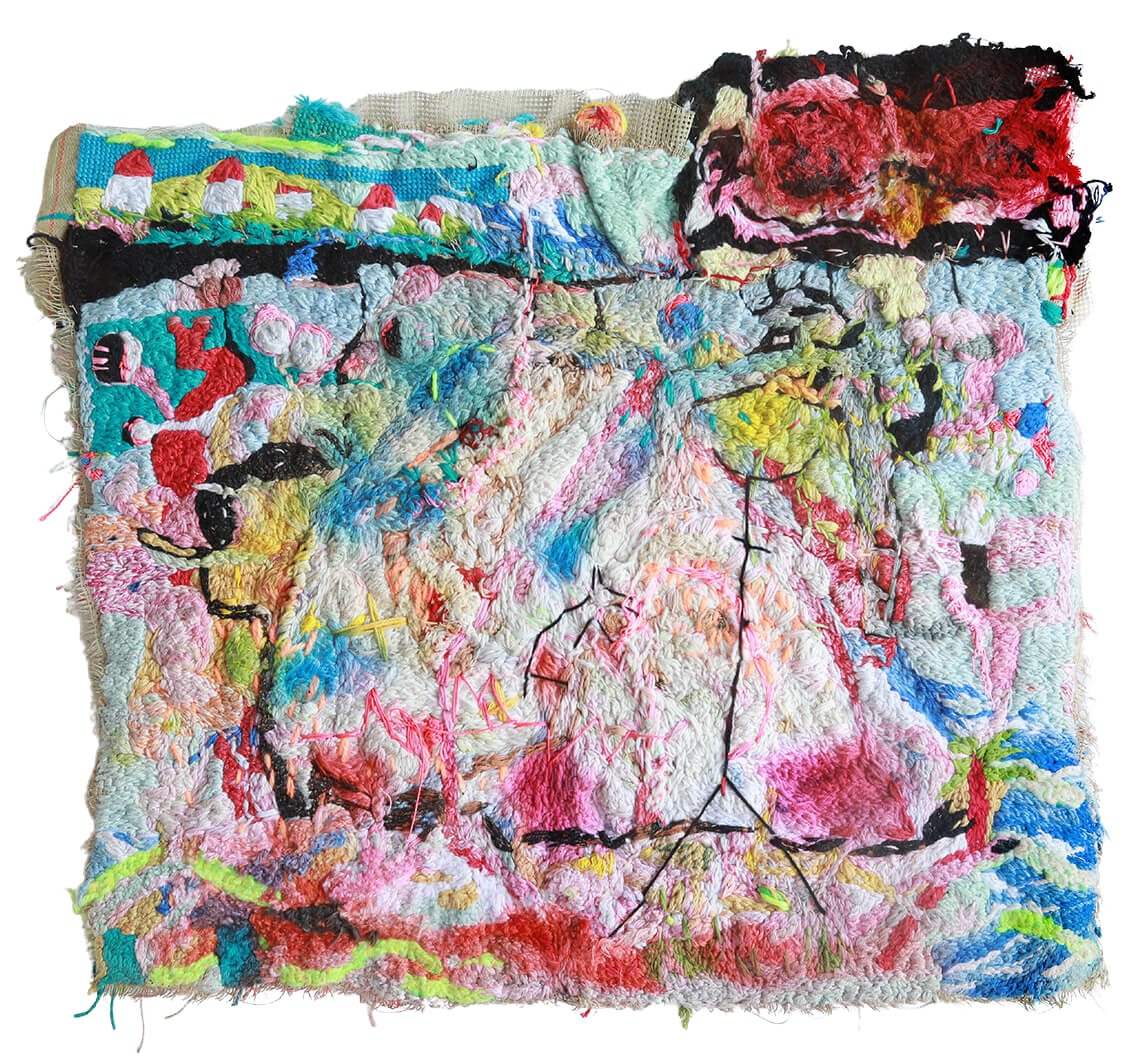"Made it freestyle and jazz"
“A series of embroideries and tapestries made since 2015, signal Lechner’s unexpected turn from painting towards a new medium of thread and wool, collage, spray paint, and objets trouvés. Initially experimenting with small-scale needleworks because of a lack of money – thread being cheaper than paints – his first works were made on an intimate scale, completed on his lap while at home, in the studio, listening to music, or traveling. Existing within the domestic tradition of illustrated embroideries sewn for pleasure – the maker following the contours of a printed image with easy-to-follow instructions and pre-designated colors – Lechner instead started with the canvas blank and, in his words, ‘made it freestyle and jazz. I took needlework to another place’ – one of violence and danger, slapstick and the uncanny, contemporary politics and existential angst.
Needlework, though, also brought to Lechner’s practice a clarity and luminosity that he had long been searching for in his paintings, where a fast technique using thickly layered, heavily impastoed paint inevitably means that his colors mix, becoming, in his words, ‘ugly, muddy, and missing light’. With textile threads, however, colors woven side by side retain their individual hues and vibrancy, not blending as liquid paints do but rather sparking off one another in dynamic combinations of pure, unadulterated color. This enables the works to come closer to achieving Lechner’s goal to ‘manifest light, the light that creates pure color. It should feel when you stand in front of my work that you’re looking at light, at energy; like the work comes to life.’
Jacky Klein, art historian
Refugees
A few years ago the media was full of heartbreaking stories about Syrian refugees jumping out of boats, sometimes drowning while desperately trying to reach safety. The Images describing the Syrian tragedy went through the media pipelines and came out as “news” published next to political speeches and gossip items about the rich and famous. We live in a mad world where terrible things happen; they get churned through the media and come out as part of the general carnival. It’s a normalization mechanism. That is the theme of this work. If you look closely, you will see the photographer filming everything while people are drowning. The scene was partly inspired by The Fight between Carnival and Lent by Pieter Brueghel the Elder, in which the carnival atmosphere becomes chaotic, dense and violent.
Untitled
This work has been brutalized – it was torn apart, drowned in chlorine, dipped in ink, unraveled and then sewn again. Images were bleached and others took their place. It was a very frustrating and long process on a work that seemed to me as if it wasn’t worth the trouble. But today this is my favourite needlework. It encompasses my views about style and technique: it has colour and drawing, abundance and reduction. Needlework is supposed to be a slow meditative process, but in my case it is no less intense than my work in other media.
Refugees
A few years ago the media was full of heartbreaking stories about Syrian refugees jumping out of boats, sometimes drowning while desperately trying to reach safety. The Images describing the Syrian tragedy went through the media pipelines and came out as “news” published next to political speeches and gossip items about the rich and famous. We live in a mad world where terrible things happen; they get churned through the media and come out as part of the general carnival. It’s a normalization mechanism. That is the theme of this work. If you look closely, you will see the photographer filming everything while people are drowning. The scene was partly inspired by The Fight between Carnival and Lent by Pieter Brueghel the Elder, in which the carnival atmosphere becomes chaotic, dense and violent.
Untitled
This work has been brutalized – it was torn apart, drowned in chlorine, dipped in ink, unraveled and then sewn again. Images were bleached and others took their place. It was a very frustrating and long process on a work that seemed to me as if it wasn’t worth the trouble. But today this is my favourite needlework. It encompasses my views about style and technique: it has colour and drawing, abundance and reduction. Needlework is supposed to be a slow meditative process, but in my case it is no less intense than my work in other media.
"Made it freestyle and jazz"
“A series of embroideries and tapestries made since 2015, signal Lechner’s unexpected turn from painting towards a new medium of thread and wool, collage, spray paint, and objets trouvés. Initially experimenting with small-scale needleworks because of a lack of money – thread being cheaper than paints – his first works were made on an intimate scale, completed on his lap while at home, in the studio, listening to music, or traveling. Existing within the domestic tradition of illustrated embroideries sewn for pleasure – the maker following the contours of a printed image with easy-to-follow instructions and pre-designated colors – Lechner instead started with the canvas blank and, in his words, ‘made it freestyle and jazz. I took needlework to another place’ – one of violence and danger, slapstick and the uncanny, contemporary politics and existential angst.
Needlework, though, also brought to Lechner’s practice a clarity and luminosity that he had long been searching for in his paintings, where a fast technique using thickly layered, heavily impastoed paint inevitably means that his colors mix, becoming, in his words, ‘ugly, muddy, and missing light’. With textile threads, however, colors woven side by side retain their individual hues and vibrancy, not blending as liquid paints do but rather sparking off one another in dynamic combinations of pure, unadulterated color. This enables the works to come closer to achieving Lechner’s goal to ‘manifest light, the light that creates pure color. It should feel when you stand in front of my work that you’re looking at light, at energy; like the work comes to life.’
Jacky Klein, art historian

